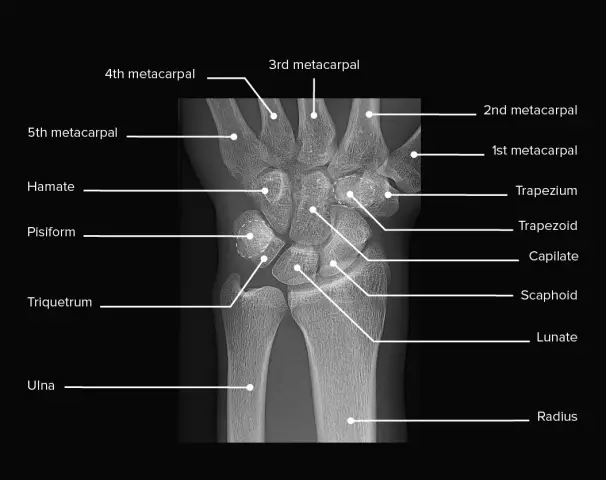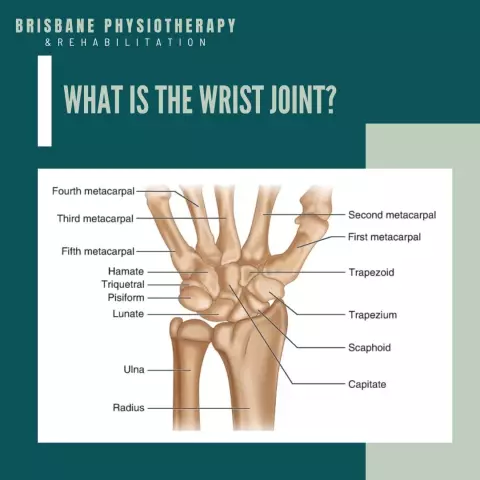- Author Curtis Blomfield [email protected].
- Public 2023-12-16 20:44.
- Last modified 2025-01-23 17:01.
Dislocation of the wrist significantly limits a person's ability to work. With an injured hand, it is impossible to perform even simple actions. This injury is quite common in both adults and children. The wrist consists of many bones, this part of the hand is very vulnerable. Often, damage occurs not only with a bruise or blow, but also with an awkward movement. Only a specialist can diagnose and treat an injury. However, every person needs to know about the symptoms and treatment of a dislocated wrist in order to provide first aid to the victim in time.
What is a dislocation
Dislocation is the displacement of articular bones relative to each other. In this case, damage to other tissues is often noted. Human joints provide movement. This is their function. But if the movements are too abrupt and go beyond the limits of the joints, then dislocation occurs. For example, a person may dislocate their jaw by opening their mouth too wide.
The bone apparatus of the wrist consists of the upper andbottom row:
- The upper includes the lunate, trihedral, pisiform and navicular bones.
- Bottom row includes capitate, trapezius and hamate.
The upper row of bones is located closer to the forearm, and the lower row is adjacent to the fingers.

In the vast majority of cases, the following types of dislocations are noted:
- Crescent. With this injury, the lunate bone rotates towards the palm and the capitate moves upward.
- Perilunar. The capitate is separated and all other bones are displaced.
The capitate and lunate bones are the most vulnerable and most often injured by impact or awkward movement. Dislocation of the wrist is always accompanied by severe damage to the ligaments and rupture of the joint capsule.
Causes of injury
What can cause such an injury? The immediate cause of the damage is a sharp flexion or extension of the joint, which goes beyond its natural mobility. Most often, the following situations lead to a dislocation of the wrist:
- The most common cause of injury is a fall on the palm of your hand. Often a person puts his hands forward. However, in this case, the main blow falls on the palm of your hand. There is a sharp flexion of the wrist joint and displacement of the bones.
- Dislocations are often observed in children. There are cases when, during a walk or when learning to walk, adults hold the baby too tightly by the wrist. If the child falls at the same time, and they try tohold, dislocation may occur.
- Dislocations can also be caused by a direct blow to the wrist during a fight or martial arts.
- Such an injury is possible when playing volleyball or basketball, as well as when doing weightlifting. Hitting the ball too hard or dropping the bar too hard can cause a dislocation.

It is important to remember that only a doctor can set the displaced bones. With self-treatment, a secondary dislocation of the wrist may occur. This is not uncommon. When a person clumsily tries to correct a dislocation, the rest of the bones of the wrist are displaced. As a result, the situation is getting worse.
Varieties of dislocations
Dislocations of the bones of the wrist can be accompanied by a complete displacement of the bone tissue. However, this injury is rare, occurring in about 10% of cases. In this case, the surfaces of the joints of the wrist are completely displaced relative to the radius. This type of injury is often complicated by fractures. In this case, doctors speak of a true dislocation.
Injuries are much more common when the articulation of the lunate and radius is preserved, but all other parts of the wrist are displaced. Such damage is seen in perilunar dislocations.
Symptoms
Symptoms of a dislocated wrist may resemble those of a fracture or bruise. Only a traumatologist can determine the type of damage. The following signs of dislocation can be distinguished:
- A person at the time of injury immediately feels a sharp pain. This is the difference between the signs of a dislocation and the symptoms of a fracture. Whenthe integrity of the bone is broken, the person may not feel pain at first due to the shock. Unpleasant feelings grow with time. With a dislocation, the pain is always instantaneous.
- The damaged area swells a lot. The swelling of the tissues is more pronounced than with a normal bruise.
- A hematoma appears on the affected area.
- The joint looks deformed. This is also a characteristic symptom of a dislocated wrist. With a fracture, such a sign is rarely observed. However, if the integrity of the articular bones is violated, then deformation is possible.
- Movement in the dislocated joint is sharply limited. A person cannot bend the wrist and pick up objects with a sick hand.
- In some types of dislocations, the patient cannot move their fingers.
- If there is nerve damage, the entire hand or individual fingers may become numb.

Sometimes it is very difficult to distinguish a dislocation from a sprain by external signs. Moreover, these two types of injury often occur together. Therefore, a final diagnosis can only be made after an x-ray.
First Aid
What to do with a dislocated wrist? As already mentioned, in no case should you try to set the displaced bones yourself. This will only lead to additional injury. It is necessary to deliver the patient to the emergency room as soon as possible. At the pre-medical stage, the patient must be provided with the following assistance:
- Cold should be applied to the sore spot. It is advisable to use an ice pack. This will help reduce swelling andpain.
- It is necessary to provide complete rest to the injured place. To do this, you need to put on a tire. It can be made from a wooden ruler or stick. The injured arm is bandaged to the tire and tied with a scarf to the chest. This position helps to reduce swelling.
- For severe pain, give the patient a Nurofen or Paracetamol tablet.

Before visiting a doctor, you should avoid moving your injured hand.
Diagnosis
The main method for diagnosing a dislocation is radiography. The examination is carried out in several projections. The picture will show the displacement of the bones relative to each other.

In some cases, an additional CT or MRI is prescribed. Such examinations are carried out if there is a suspicion of damage to the nerves or ligamentous apparatus.
Conservative treatment
Treatment of dislocation of the wrist begins with the reduction of displaced bones. This procedure is performed under local anesthesia. The traumatologist together with the assistant eliminate the displacement of the bones.

Then a plaster cast is applied to the injured limb. It must be worn for 2 weeks. After this period, a second X-ray examination is carried out.
Instead of a cast, you can use an orthosis. This is a more convenient device for fixing an injured limb. The orthosis does not rub or irritate the skin and is resistant to water.

To relieve pain, the following drugs are prescribed:
- "Ketanov";
- "Nise";
- "Ibuprofen";
- "Celebrex".
In case of severe pain, the appointment of analgesics with codeine is indicated: "Sedalgin", "Pentalgin", "Nurofen plus". However, these drugs are strictly prescription drugs. Only a doctor can decide on the need for their use and determine the dosage.
In severe cases, corticosteroid hormones and local anesthetics are injected directly into the joint cavity. Treatment is continued until the pain subsides.
Surgery
Surgical treatment of a dislocated wrist has to be resorted to in advanced cases. If a person asked for help only 2-3 weeks after the injury, then usually conservative therapy is ineffective. In this case, open surgery is performed on the joint. It is done under general anesthesia.
The surgeon brings the displaced bones into the correct position. Then their ends are fixed with a metal rod. This device is passed through the skin and removed after some time.
The recovery period after surgery can take quite a long time - from 6 to 12 months. Therefore, in case of dislocation, it is necessary not to delay the visit to the traumatologist. This will help you recover and recover faster.
Rehabilitation period
The main task of rehabilitation after an injury isrestoration of motion in the wrist. To this end, the following activities are carried out:
- Massage. This procedure is performed to prevent muscle atrophy. The hand is massaged, starting from the area of the shoulder and forearm. The wrist area should only be subjected to very light exposure.
- Physiotherapy treatments. Assign treatment with a laser, magnet, ultrasound, as well as UHF therapy. This helps to improve blood circulation in tissues and rapid regeneration.
- Therapeutic exercise. Exercises are carried out for flexion and extension of the hand and fingers, circular movements, holding various objects, squeezing the ball. This contributes to the restoration of joint function.
The length of the rehabilitation period may vary. It depends on the type of dislocation, the presence of damage to the nerves and ligaments, as well as on possible complications. If the appeal to the doctor was timely, then in most cases the movements in the hand are restored quickly. If the patient underwent open surgery on the joint, then the rehabilitation process can drag on for many months.
The consequences of injury
Even after a dislocated wrist is completely healed, a person may still feel the effects of the injury for a long time. The patient may experience intermittent pain in the healed joint, which sometimes becomes chronic. Here, much depends on how timely the patient sought medical help. The earlier the dislocation was reduced, the greater the chance that the damage will pass without complications.
Dislocations accompanied bynerve damage or complicated by osteoarthritis. If a person had inflammation in the wrist joint before the injury, then the rehabilitation process will be long.
Dislocation resolves without consequences if the damage was small, and assistance was provided in a timely manner. If the appeal to the doctor was belated, then even after the treatment of the injury, not only pain is often noted, but also a violation of the mobility of the hand or fingers. In this case, a long rehabilitation may be required.
Prevention
How to prevent a sprained wrist? To avoid injury, you must adhere to the following recommendations:
- Be careful when walking on slippery surfaces to avoid falling. In winter, shoes should be worn that provide firm grip of the sole with ice.
- During the fall, do not put forward straightened arms.
- You need to regularly eat foods rich in calcium. This will help strengthen bones and joints.
- It is useful to do exercises to strengthen the muscles of the lower extremities. such as brisk walking. This will help you stay on your feet and avoid falling.
- When playing sports, you need to protect your wrists with special equipment.
These simple measures will help minimize the risk of dislocation.






